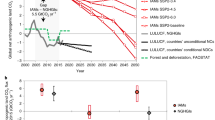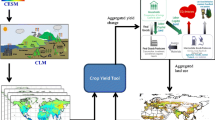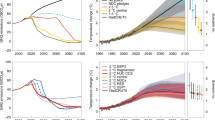Abstract
100-year Global Warming Potentials (GWPs) are used almost universally to compare emissions of greenhouse gases in national inventories and reduction targets. GWPs have been criticised on several grounds, but little work has been done to determine global mitigation costs under alternative physics-based metrics . We used the integrated assessment model MESSAGE to compare emission pathways and abatement costs for fixed and time-dependent variants of the Global Temperature Change Potential (GTP) with those based on GWPs, for a policy goal of limiting the radiative forcing to a specified level in the year 2100. We find that fixed 100-year GTPs would increase global abatement costs (discounted and aggregated over the 21st century) under this policy goal by 5–20 % relative to 100-year GWPs, whereas time-varying GTPs would reduce costs by about 5 %. These cost differences are smaller than differences arising from alternative assumptions regarding agricultural mitigation potential and much smaller than those arising from alternative radiative forcing targets. Using the land-use model GLOBIOM, we show that alternative metrics affect food production differently in different world regions depending on regional characteristics of future land-use change to meet growing food demand. We conclude that under scenarios of complete participation, the choice of metric has a limited impact on global abatement costs but could be important for the political economy of regional and sectoral participation in collective mitigation efforts, in particular changing costs and gains over time for agriculture and energy-intensive sectors.




Similar content being viewed by others
Notes
If other potential or implicit goals of climate policy are included explicitly, such as limiting the rate of warming as well as its long-term absolute magnitude, the economically optimal exchange rate changes and can resemble 100-year GWPs much more closely (Manne and Richels 2001).
References
Cox PM, Jeffery HA (2010) Methane radiative forcing controls the allowable CO2 emissions for climate stabilization. Curr Opin Environ Sustain 2(5–6):404–408
de Vries M, de Boer IJM (2010) Comparing environmental impacts for livestock products: a review of life cycle assessments. Livest Sci 128(1):1–11
FAO (2010) Greenhouse gas emissions from the dairy sector: A life cycle assessment. Animal Production and Health Division, Food and Agriculture Organisation, Rome
Fisher BS, Nakicenovic N, Alfsen K et al (2007) Issues related to mitigation in the long-term context. In: Metz B, Davidson OR, Bosch PR et al (eds) Climate change 2007: Mitigation. Contribution of Working Group III to the Fourth Assessment Report of the Intergovernmental Panel on Climate Change. Cambridge University Press, Cambridge
Forster P, Ramaswamy V, Artaxo P et al (2007) Changes in atmospheric constituents and radiative forcing. In: Solomon S, Qin D, Manning M et al (eds) Climate change 2007: The physical science basis. Contribution of Working Group I to the Fourth Assessment Report of the Intergovernmental Panel on Climate Change. Cambridge University Press, Cambridge
Fuglestvedt JS, Shine KP, Berntsen T et al (2010) Transport impacts on atmosphere and climate: metrics. Atmos Environ 44(37):4648–4677
Havlík P, Schneider UA, Schmid E et al (2011) Global land-use implications of first and second generation biofuel targets. Energy Policy 39:5690–5702
IPCC (2009) In: Plattner G-K, Stocker TF, Midgley P et al (eds) Meeting report of the expert meeting on the science of alternative metrics. IPCC WGI Technical Support Unit, Bern, pp 75
Johansson DJA (2011) Economics- and physical-based metrics for comparing greenhouse gases. Clim Change 110(1–2):123–141
Johansson DJA, Persson U, Azar C (2006) The cost of using global warming potentials: analysing the trade off between CO2, CH4 and N2O. Clim Chang 77(3):291–309
Lucas PL, van Vuuren DP, Olivier JGJ et al (2007) Long-term reduction potential of non-CO2 greenhouse gases. Environ Sci Policy 10(2):85–103
Manne AS, Richels RG (2001) An alternative approach to establishing trade-offs among greenhouse gases. Nature 410(6829):675–677
Rao S, Riahi K (2006) The role of non-CO2 greenhouse gases in climate change mitigation: long-term scenarios for the 21st century. Energy J 27(Special Issue November 2006):177–200
Rao S, Riahi K, Cho C et al (2008) IMAGE and MESSAGE scenarios limiting GHG concentrations to low levels. IIASA Interim Report IR-08-020. Report for IIASA, Laxenburg, Austria
Reilly J, Mayer M, Harnisch J (2002) The Kyoto protocol and non-CO2 greenhouse gases and carbon sinks. Environ Model Assess 7:217–229
Reisinger A, Meinshausen M, Manning M et al (2010) Uncertainties of global warming metrics: CO2 and CH4. Geophys Res Lett 37(14):L14707
Riahi K, Grübler A, Nakicenovic N (2007) Scenarios of long-term socio-economic and environmental development under climate stabilization. Technol Forecast Soc Change 74(7):887–935
Riahi K, Dentener F, Gielen D et al (2012) Energy pathways for sustainable development. In: Gomez-Echeverri L, Johansson TB, Nakicenovic N (eds) The global energy assessment: toward a more sustainable future. Cambridge University Press and IIASA, Cambridge
Shine KP (2009) The global warming potential—the need for an interdisciplinary retrial. Clim Chang 96(4):467–472
Shine KP, Derwent RG, Wuebbles DJ et al (1990) Radiative forcing of climate. In: Houghton JT, Jenkins GJ, Ephraums JJ (eds) Climate change: The IPCC scientific assessment. Cambridge University Press, Cambridge
Shine KP, Fuglestvedt J, Hailemariam K et al (2005) Alternatives to the global warming potential for comparing climate impacts of emissions of greenhouse gases. Clim Chang 68(3):281–302
Shine KP, Berntsen T, Fuglestvedt J et al (2007) Comparing the climate effect of emissions of short- and long-lived climate agents. Phil Trans Roy Soc A 365(1856):1903–1914
Stehfest E, Bouwman L, van Vuuren D et al (2009) Climate benefits of changing diet. Clim Chang 95(1):83–102
Tanaka K, Peters GP, Fuglestvedt JS (2010) Policy update: multicomponent climate policy: why do emission metrics matter? Carbon Manag 1(2):191–197
UNFCCC (2010) The Cancun Agreements: Outcome of the work of the Ad Hoc Working Group on Long-term Cooperative Action under the Convention. UNFCCC, FCCC/1.CP16, pp31.
Valin H, Havlik P, Mosnier A et al (2010) Climate change mitigation and future food consumption patterns. Paper presented at 1th Joint EAAE/AAEA Seminar, 15–17 September 2010, Freising, Germany
van Vuuren D, Weyant J, de la Chesnaye F (2006a) Multi-gas scenarios to stabilize radiative forcing. Energy Econ 28(1):102–120
van Vuuren DP, Eickhout B, Lucas P et al (2006b) Long-term multi-gas scenarios to stabilise radiative forcing – exploring costs and benefits within an integrated assessment framework. Energ J 27(Special Issue November 2006):201–234
van Vuuren D, den Elzen M, Lucas P et al (2007) Stabilizing greenhouse gas concentrations at low levels: an assessment of reduction strategies and costs. Clim Chang 81(2):119–159
Acknowledgements
A.R. was funded by the New Zealand Ministry for Primary Industries under contract C10X1010. The work and models presented in this article have also been supported by the EU-funded FP7 projects ANIMALCHANGE (grant no. 266018), CC-TAME (grant no. 212535), GHG-Europe (grant no. 244122), LIMITS (grant no. 282846), and PASHMINA (grant no. 244766). Very constructive comments from three anonymous reviewers greatly helped improve the manuscript and clarify its key assumptions.
Author information
Authors and Affiliations
Corresponding author
Electronic supplementary material
Below is the link to the electronic supplementary material.
ESM 1
(PDF 458 KB)
Rights and permissions
About this article
Cite this article
Reisinger, A., Havlik, P., Riahi, K. et al. Implications of alternative metrics for global mitigation costs and greenhouse gas emissions from agriculture. Climatic Change 117, 677–690 (2013). https://doi.org/10.1007/s10584-012-0593-3
Received:
Accepted:
Published:
Issue Date:
DOI: https://doi.org/10.1007/s10584-012-0593-3




